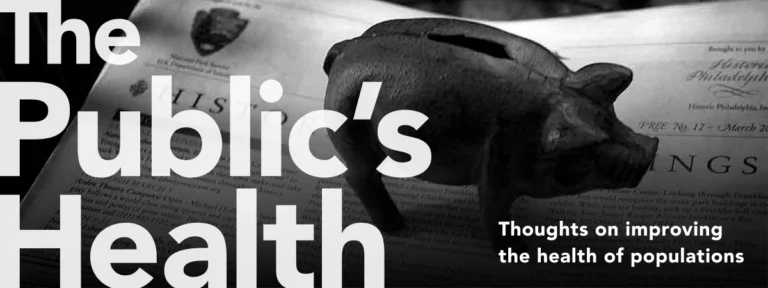Can We Promote Public Health and Generate Return on Our Investment?
It is widely recognized that the United States spends far more on health, or perhaps more accurately, on medical care than any other country on earth.

Read Time: 6 minutes
Published:

Can We Promote Public Health and Generate Return on Our Investment?
It is widely recognized that the United States spends far more on health, or perhaps more accurately, on medical care than any other country on earth. This leads to a considerable amount of hand-wringing, and also some well-considered ideas about how we can spend our medicine dollars better. While most thinking about how we may best spend our health dollars features, at heart, some scenario of greater spending on prevention, our health spending remains resolutely curative. Of the $3.3 trillion spent on health in 2016, only about 2% of that was spent on classic public health activities such as disease monitoring and surveillance.
We might suggest that this is misaligned with what we really want for our own and our children’s lives. To put it more prosaically, wouldn’t we rather never develop Alzheimer’s than receive treatment for our Alzheimer’s once we get it? Few people ever express a preference for cure over prevention.
But leaving aside what we might prefer, perhaps we spend more on cure than we do on promoting health because prevention and keeping people healthy are too expensive. That would be a robust argument for spending less in this area since, after all, we all recognize that all spending is zero sum and we have to make choices about what to spend money on.
But is it true that keeping us healthy is too expensive? An analysis set out to assess the return on investment for high-income countries that adopt efforts to improve health. The authors conducted a systematic review of nearly 3,000 papers. They found that the median return on investment for public health interventions was 14 to 1, that is, for every dollar invested, it yields the same dollar back and another 14. They found that the more these interventions were established at the wider, national level, the higher the return, rising up to about 40 to 1 for the best investments. What are these interventions? They include, among other efforts, vaccination programs, taxes on sugar sweetened beverages, building better cities to reduce falls, and early youth interventions to limit teenage pregnancy and delinquency. In other words, classic efforts that create healthier worlds and promote the public’s health.
If we could improve the public’s health and improve our bottom line by investing in what are sometimes called “upstream” efforts, then why do we not do this? Inertia, we suspect, plays a big role here, and a longstanding mismatch in this country between what we value in health and what we do about it.
Warmly,
Michael Stein & Sandro Galea

DIETS AND DYING
A suboptimal diet is a major cause of cardiovascular disease and diabetes (CDD). These authors estimated the potential impact on deaths from CDD if participants received economic incentives to change intakes of seven key food groups. These groups were fruits, vegetables, whole grains, nuts/seeds, sugar sweetened beverages, and processed and unprocessed red meat. Previous work estimated that a joint 10% price change in all seven groups prevented 3.4% of all CMD deaths. A larger price change (30%) was estimated to prevent 9.2% of all CMD deaths. Decreasing prices of fruits and increasing prices of sugar sweetened drinks produced the largest observable impact. Policymakers could implement nutrient- and food-specific taxes, but the efficacy of these taxes on harmful foods will largely depend on what products consumers choose as alternatives.
DEATH BY PARTNER
Nearly half of female homicide victims are killed by a current or former male intimate partner. This intimate partner violence (IPV) takes the lives of over 3,500 women and girls a year. Using the CDC’s National Violent Death Reporting System (NVDRS), the authors note that half of all homicides (55.3%) were IPV-related. 11.2% of victims experienced some form of violence, commonly precipitated by argument and jealousy, in the month preceding their deaths. The largest proportion of victims were either never married or single at the time of death and under age 30. Blacks and Hispanics were disproportionately affected. Approximately 15% of 18-44 year-old women were pregnant or less than 7 weeks postpartum when murdered. Strategies to prevent IPV-related homicides range from protecting women from immediate harm at the time of physical or sexual assault, intervening in current IPV, and developing and implementing programs to connect women with counseling, housing, and legal advocacy. Since guns were used in 54% of these homicides, state statutes limiting access to firearms for persons under a domestic violence restraining order may be another preventive measure.

DISABILITY, RACE, AND THE RISK OF ARREST
The deaths of Magdiel Sanchez and Anthony Hill made international headlines after they were shot and killed by police officers. Sanchez was deaf, unable to hear the officers’ commands, and Hill was a veteran with a history of mental illness. The violent interactions between the police and public that get the most attention are usually centered around race. Less is known about violent interactions between the police and people with disabilities.
Erin J. McCauley conducted a study using data from the National Longitudinal Survey of Youth to estimate the likelihood of arrest in the United States by the age of 28 by disability status, race/ethnicity, and gender. McCauley assessed the presence of sensory, physical, emotional, and cognitive disabilities using parental reporting data from 1997 and self-reported data from 2002.
The likelihood of arrest differed significantly between those with a disability and those without. In the graphs above, it is apparent that those with disabilities had a higher probability of being arrested across all races. Nearly 43% of the sample with a disability (graph b) was arrested by age 28 compared to nearly 30% of those without a disability (graph a).
For Black youth and young adults, this difference was more drastic. Those with a disability had a 55% likelihood of arrest compared to 37% for Black youth and young adults without a disability. McCauley notes several limitations to this study, including a small sample size and the use of self-reported data.
Race/ethnicity and disability status can play a major role in experiences with law enforcement. McCauley recommends educating the police about how their personal biases might affect their interactions with those who have disabilities as a potential way to protect this vulnerable population. —Chrissy Packtor, PHP Fellow
Graphic: FIGURE 1—Age-Specific Probabilities of Arrest for (a) People Without Disabilities and (b) People With Disabilities: National Longitudinal Survey of Youth 1997, United States, 1997– 2014. Erin J. McCauley, “The Cumulative Probability of Arrest by Age 28 Years in the United States by Disability Status, Race/Ethnicity, and Gender,” American Journal of Public Health 107, no. 12 (December 1, 2017): pp. 1977-1981. DOI: 10.2105/AJPH.2017.304095





